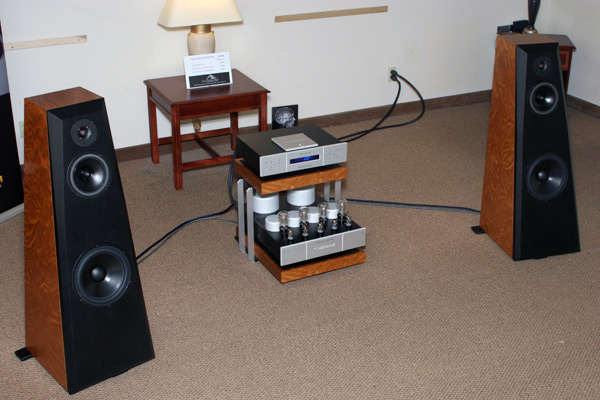![[SoundStage!]](../../titles/sslogo3.gif) Home
Audio Equipment Home
Audio EquipmentFeature Review |
||
Audiophiles are a tough bunch to please. On the one hand, the goal for any audiophile should be to obtain the very best sonic reproduction possible given budget constraints. On the other hand, many audiophiles do things that impede their chances of getting the best sound for their money. Take loudspeakers and amplifiers, for example. It has long been known that the amplifier/speaker interface is crucial to attaining the best sound, and that active loudspeakers -- loudspeakers that have amplifiers built specially for them, either as a separate unit or housed right inside the cabinet -- take all of the guesswork out of mixing and matching because the designer has done it for you. The problem is, many audiophiles refuse to entertain this approach. Instead they haphazardly shop for loudspeakers and amplifiers and all of the other components, trying to get it right themselves. I suspect that if these same people could hear the Aurum Acoustics Integris CDP/Active 300B system many of them would change their hunting-and-pecking ways. Designer Derrick Moss has created one of the best-sounding audio systems I've heard anywhere. The whole she-bang retails for $42,000 (sans some accessories described below), which to some will sound steep; however, the Integris CDP/Active 300B system is a world-class performer that hangs with the best out there and can cost a lot more. The Integris CDP and Active 300B are actually four physical components that function as one complete system. There’s no real tweaking to be done, and the only tailoring involves how you set everything up in your room.
But no one’s going to say the driver complement is all that ordinary, particularly the midrange, which I haven’t seen used in any other speakers. Moss picked all of the drivers strictly for their performance, not just to have some brand name moving air. The tweeter is a 1" fabric-dome SEAS Excel. It’s a ferrofluid-less design, which, Moss says, yields superior microdynamic performance providing you don’t lay into it with too much power. The woofer is a 10" treated paper-cone design from SEAS as well. The midrange driver I mentioned is also a treated-paper-cone design, but a 6" unit that comes from B&C Components of Italy. Moss doesn’t care that practically no one has heard of this midrange driver before. He calls it "a true midrange driver" (as opposed to "a mid-woofer") and claims that it will deliver a whopping 98dB of output with just 1W input. Finally, it’s worth mentioning that there are no ports; the Integris Active 300B is a sealed speaker. The amplifier is a single-chassis, six-channel unit -- one channel for each driver. Thus four of the channels supply tube-based power to the midranges and tweeters, with the remaining two solid-state channels driving the woofers. Derrick and company designed the 300B-based tube channels, which deliver "about 5 watts." Bryston developed the two solid-state channels, and they deliver 100 watts. While 5 watts may not seem like a lot of power (frankly, it’s not), for midrange and tweeter drivers, it can be sufficient, particularly if the drivers' sensitivity is high enough. That’s why the 98dB B&C midrange is so critical. Bass drivers, on the other hand, need more power; hence, the 100 solid-state watts on the bottom end.
The amplifier with tubes installed measures 19"W x 10"H 23"D. It’s pretty big, and it weighs a hefty 70 pounds -- a testament to its thick-aluminum chassis. The amp’s power switch is on the back panel, as are all the speaker connectors. One nice feature is that the amplifier can be "triggered" on from a source component, providing you have the included cable installed. This means that you don’t have to bend over and turn the amp on and off. What’s not so apparent is the crossover. It’s in the amp, and it works at line level, which means ahead of the amplifier stage. This means that the amps are connected to the drivers with only cabling in the path, not crossover components as you have with conventional passive loudspeakers. According to Moss, having a crossover between the amp and drivers is like sticking "a sponge" in there. In his system, the amps have an iron grip on the drivers. The acoustic crossover uses fourth-order slopes at 320Hz (woofer to midrange) and 1.9kHz (midrange to tweeter). The use of steep slopes and a transition from midrange to tweeter at quite low frequencies are hallmarks of designs based on the National Research Council’s ‘70s and ‘80s research, which brought to light the importance of frequency-response linearity and controlled dispersion. Despite being too young to have actually participated in that research, Moss knows the NRC findings well. In fact, he owns a copy of the NRC’s world-famous "Green Book," and he describes the acoustical output of his design as "classic NRC." As a result, he claims on-axis linearity of +/-1.5dB from 40Hz to 20kHz, and 45-degrees off-axis he says it’s +/-1.5dB to 10kHz. If that’s all true, this is a very linear design, both on- and off-axis. And for those who might raise an eyebrow or two at the 40Hz low point, thinking "not low enough," Moss claims a -3dB point of 30Hz, -6dB at 24Hz, and -10dB at 20Hz -- these are more telling of in-room response. The Integris Active 300B speaker system is designed to be full range.
Because the entire system was designed to work together, setup was a snap. Admittedly, though, this was because Derrick Moss also dropped off his custom-made electronics stand, which provides an ultra-rigid structure for the electronics to rest on (the stand is not included and costs $3000). The Integris CDP sits on the top shelf and the Integris Active 300B amplifier on the bottom, with a one-meter pair of Cardas Golden Reference interconnects tethering them (the interconnects are also not included; they cost $800). As well, the short "trigger" cord is also attached to the CDP and amp to turn the amplifier on when the CDP is powered on. Out the back of the amplifier are connected two runs of speaker cables to each speaker. One run is four-pin XLR terminated, and that’s used for the tweeter and midrange units. The other run is a more typically terminated speaker cable (i.e., with spades) that attaches to Cardas binding posts on the back of the amp and speakers. The speaker cabling, which Aurum designed and manufactures specifically for the Active 300B, uses Cardas wire. It is included in the speaker system’s price. The power cords Derrick sent me aren’t included. These custom-made cables are made by Cardas to Aurum's specifications and use Cardas wire. They are priced at $800 each. I used them on the amp and CD player/preamp. As well, Moss also dropped off optional aluminum speaker braces ($400 each) that give the speakers a more solid footing on the floor. That means the full-boat Aurum system, including source, amplifier, speakers, and all the optional Aurum accessories, costs $47,800. That's a hefty chunk of change. Thankfully, my household insurance was paid up. Powering on the system is easy and, even with tubes, foolproof. In fact, Moss declared the system "virtually unbreakable." For day-day-day listening, you hit the Standby switch on the CD player/preamp's faceplate or remote control. When the Integris CDP lights up, so does the amp, although it goes through a short muted phase as the tube and solid-state portions power on. There are no unpleasant bumps, thumps, or other such sounds as the system turns on or off -- just a few clicks, and then music starts playing if you already have a CD spinning.
Speaker positioning for optimum sound proved simple as well. Moss likes to listen nearfield and set the speakers up with about a seven-foot spread and a distance from the listening seat of about the same. He thought this positioning was good, but I found it all too close. I moved the speakers well away from the front and side walls, with an eight-foot spread between them and a listening distance of about ten feet. I used a touch of toe-in and the result was, to my ears, perfect. And by perfect, I mean perfect -- or as close to that as any audio system gets. The Aurum Acoustics system has the most balanced, easy-on-the-ears and cohesive presentation I’ve heard from any complete system -- at shows or in my listening room. As a matter of fact, it’s so "right-sounding" that writing about it is something of a chore. I wanted to listen, not analyze. For example, take the opening track of Blue Rodeo’s Five Days in July [Discovery 77013], "5 Days in May." Rumor has it that it was recorded at Greg Keelor’s farmhouse in Ontario on a hot summer night, and it sounds like it. There’s a warm, rich, vibrant sound with an enormous soundstage and great image specificity. Now, granted, every system I play this on creates an impressive stage -- even through speakers that are a couple hundred bucks -- but nothing I’ve heard is like what comes out of the Aurum system. I’ve had all kinds of speakers in here, big and small, and nothing has created as spacious a stage, or presented the same level of detail inside. Furthermore, the midrange was utterly pure, making the voices sound extremely detailed and wonderfully clear. And it was the same with the top end; cymbals were pristine and effortless, with a feathery, airy quality. The sound was superbly transparent from top to bottom. I feared at first that the speakers might be bass shy because their low end wasn't jumping out at me. But when I least expected it, the bass would fill in and the room would swell. No doubt, bass was there and in sufficient quantities. What I learned was that the upper-bass region wasn’t pumped up, as it is with some more ear-catching speakers. Overall, the Integris Active 300B adds little coloration to the sound. Put another way, the Aurum system lacks the pyrotechnic thrills that some systems display -- in the bass and higher up. And if you think because this system uses tubes on the mids and highs that it has some gross, tubey colorations, think again. The midrange was as pure-sounding as can be, but it was never syrupy or overly warm in the way that some tube-based systems are. If anyone’s going to say anything about the midrange, it will be that it's a touch laid-back, but it certainly doesn’t exhibit tubey softness. Focus and transparency dominate. Whether you think such fidelity is good or bad will depend on your listening preferences. Over the course of my listening, I appreciated this system more and more, and I dreaded the day when Moss would arrive to pack it all up. From my oldest recordings to my newest, from the lousiest recordings to the very best, the Aurum system never ceased to amaze me with how well it could convey the music -- its detail, flow and beauty. It was as revealing a system as I’ve heard, but it never emphasized detail. It simply passed it along. I remember when I pulled out Van Morrison’s Hymns to the Silence [Mercury 849026-2]. This is not a great recording, but it is great music, and the Aurum system didn’t mask a thing. Every flaw, whether it was the limited frequency response, the restrained dynamics or the lack depth and dimensionality, came through. More important, the Aurum system didn’t exacerbate those problems as lesser systems do. That’s downright offensive! Flawed or not, what came through was the best darn rendition of this two-disc release that I’ve ever heard. In contrast, when the recording is first-rate, as is Mariza’s Transparente [EMI 9047], prepare to pick up your jaw and open your wallet -- if you’re the kind of person who might be able to drop big bucks on a complete system. This unique system is about all-out performance. Mariza’s rich voice seemed to hang in space, the musicians surrounding her and the hall enveloping all of it of. The clarity and the delineation between musicians and the space around them was astounding. If people want to know what high-end audio is about, they need to hear the Aurum Acoustics system. In our SoundStage! reviews it is customary to compare the product under review to one or more competitors. After all, that’s the way to indicate how a preamp, for instance, will fare in the marketplace. The problem here is that the review product is a complete system, including an active loudspeaker. A few months ago I reviewed the excellent NHT Xd, an elaborate active loudspeaker system that has a DSP-based crossover and uses digital amps to power satellite speakers and a subwoofer. It needs a source/preamp like the Integris CDP, so I used the two together for a short time. The Xd system is miniscule in comparison to the Aurum Integris Active 300B, and suitable for a much smaller room. Furthermore, the Xd system is designed to sound excellent at its $6000 price point, whereas the Integris Active 300B is designed to sound excellent, period. While price doesn’t always correlate with performance, in this case it does. Across the board, Aurum’s Integris Active 300B sounds superior, not just in terms of things like bass depth and overall scale of presentation, but in terms of detail, clarity, and a whole host of other things. So it should at five times the price. My criticisms of the Aurum Acoustics system are few. In fact, my biggest criticism has to do with the fact that for $42,000 for the necessary bits, there are other collections of equipment that look better -- by that I mean sexier cosmetics. As I mentioned, the Aurum speakers look rather ordinary, and for some buyers, that will be a demerit. The sound, though, isn’t ordinary at all. In fact, the Aurum system is remarkable for its coloration-free presentation, proving that you can never judge the sound of a speaker system with your eyes. The same thing can be said about the Integris CDP as well. Aurum Acoustics’ Integris CDP and Active 300B comprise one of the most resolving, revealing, and pleasing stereo systems I’ve ever heard. I suspect that such performance has mostly to do with one skilled designer overseeing the creation of the entire system, imparting his own views for what makes great sound and making all decisions to achieve it. Aurum’s approach is unique, but it works. And while the prices of individual components might not seem cheap, all are state-of-the-art performers. I hated to see them go. ...Doug Schneider
|
||
|
||
![[SoundStage!]](../../titles/sslogo3.gif) All
Contents All
ContentsCopyright © 2006 SoundStage! All Rights Reserved |


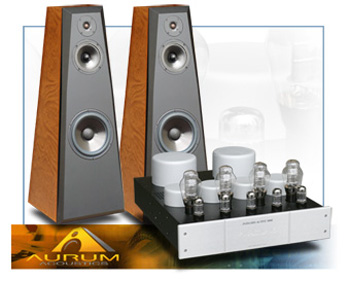
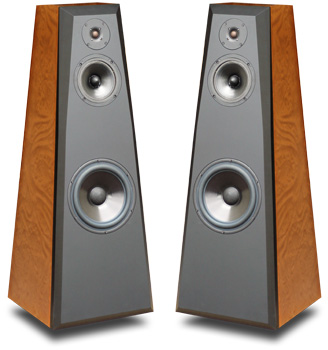 First, there are the
44"-high speakers, which slope on the front baffle and one side. They’re made of
1" MDF on the left, right, and back, as well as bottom and top, while the sloped
baffle (Aurum says 10 degrees) is 2" thick. Each speaker weighs 100 pounds. Overall
build quality and finish of the speakers are good. The review pair came with dark-colored
hardwood veneer on all sides except for the front baffle, which is finished in matte
black. In comparison to some of the pricier competition, with their sculpted cabinets and
luxury-auto finishes, Aurum’s speakers look a tad ordinary.
First, there are the
44"-high speakers, which slope on the front baffle and one side. They’re made of
1" MDF on the left, right, and back, as well as bottom and top, while the sloped
baffle (Aurum says 10 degrees) is 2" thick. Each speaker weighs 100 pounds. Overall
build quality and finish of the speakers are good. The review pair came with dark-colored
hardwood veneer on all sides except for the front baffle, which is finished in matte
black. In comparison to some of the pricier competition, with their sculpted cabinets and
luxury-auto finishes, Aurum’s speakers look a tad ordinary.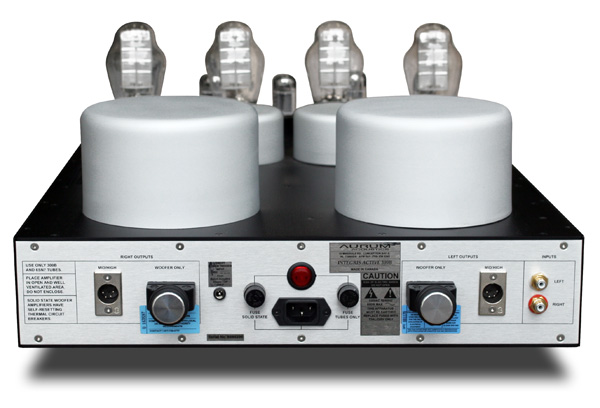
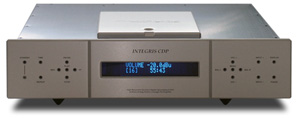 The other main piece of the
Aurum Acoustics system is the Integris CDP,
The other main piece of the
Aurum Acoustics system is the Integris CDP, 